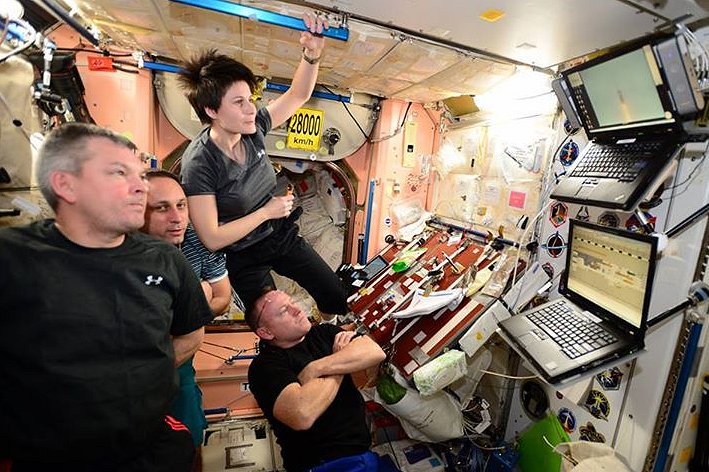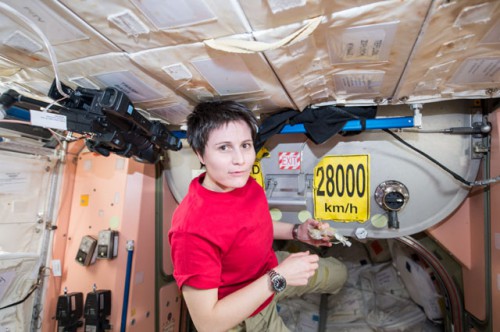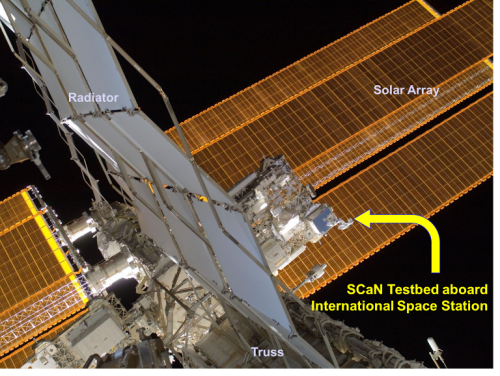
SPACE STATION WEEKLY RECAP 12/8/2014 – 12/14/2014 — The members on board the International Space Station (ISS) were hard at work last week, performing research work and preparing for the upcoming SpaceX Dragon CRS-5 visit.
NASA astronaut Terry Virts worked on the Device for the study of Critical Liquids and Crystallization (DECLIC HTI-R) study last week. He removed the High Temperature Insert from the device. The High Temperature Insert will be sent back to Earth via the SpaceX-5 resupply mission in January 2015.
DECLIC HTI-R is an experiment on the ISS from the French Space Agency (CNES). It studies water when it is close to its critical point—when water begins to behave as a dense gas—as the difference between it being a liquid and a vapor is less distinguishable. When temperatures and pressures exceed this point, salt is inclined to precipitate from water. The results will tell researchers how, on a molecular level, an array of materials transform from liquid to solid to gas and back again.

Findings from this study will help to aid in the design of extended-life, low-maintenance water oxidation reactors which will be resistant to deposits from salt and corrosion, leading to a more environmentally friendly waste management system to reduce operation costs of power plants on Earth using water as its means of working or coolant fluid.
Virts also finished the initial measurement for a new human research investigation which will study Factors Contributing the Food Acceptability and Consumption, Mood, and Stress on Long Term Space Missions (Astro Palate).
We know that moods and stress play a critical role in the physical health of astronauts, and that the spaceflight experience is inherently stressful. Therefore, every chance available to lessen the stress associated with it is crucial to the future of space travel. That’s where products like CBD Oil can come pretty handy, you should browse around this website to learn more about CBD.
This investigation will study how emotions, mood, stress, and eating during spaceflight are related and look for methods of minimizing the stressful parts of crew members eating in space, so that they may eat and enjoy more foods. It will also examine the way the astronauts ability to choose their food, as opposed to having it selected for them, affects their moods.
Also, it looks at ways to use eating as a means to reduce stress or negative moods crews may have during space travel when they eat alone, compared to eating with others, or being offered an individually unique meal on special occasions.
A number of NASA communications network events were run on the space station this week by the ground team for the Space Communications and Navigations (SCaN) Testbed. Designed at NASA’s Glenn Research Center in Cleveland, SCaN is a flexible radio system which conforms to common, non-proprietary standards. This gives agency flight controllers the ability to adjust the software and the way the equipment is used during flight. It also would allow crews and ground teams to make a recovery from unexpected errors or changes in the system.
Being able to change the software of a radio after launch would enable mission operators working from the ground to enhance communication systems, allowing for increased flow of information, and the possibility to fix issues in the communications systems. It would also lessen cost and risk by using the same hardware platform for different missions and only changing software per the needs of the mission.

Radio technology created for space use could also possibly serve a dual-purpose on Earth, like being used for satellite radio platforms, resulting in the development of open standards.
In an effort to better understand how fires behave in space, work was completed on the Flame Extinguishment Experiment-2 (FLEX-2) investigation. The team that supports the experiment finished a checkout of hardware installed recently and calibrated the Binary-Droplet Array test matrix. When this was finished, NASA astronaut Barry “Butch” Wilmore replaced the Combustion Integrated Rack (CIR) manifold.
The FLEX-2 experiment uses small droplets of fuel to investigate the special burning characteristics of fires that take place in space. It looks at the rate and manner of burning fuel, what conditions are required for the formation of soot, and how a mixture of fuels evaporates before it burns. Research gathered from this study will provide data relevant to increasing the fuel efficiency of engines that use liquid fuels. Also, it will help scientists to gain a clearer understanding of combustion-generated pollution and fire hazards associated with liquid combustibles, on Earth.
Also last week, Wilmore and Italian astronaut Samantha Cristoforetti got a refresher on their robotics skills in preparation for the upcoming capture of the SpaceX Dragon’s with the Canadarm2. The fifth SpaceX cargo resupply mission is scheduled to launch to the ISS at 1:20pm EST on Friday, Dec. 19, 2014, from Space Launch Complex 40 at Cape Canaveral Air Force Station in Florida.
Wilmore and Cristoforetti will monitor Dragon from inside the Cupola as it approaches the ISS. Wilmore will take control of the Canadarm2 and Cristoforetti will be his backup.
On the Russian part of the station, cosmonauts Alexander Samokutyaev and Elena Serova worked on further studies of micrometeoroid detection techniques, while Flight Engineer Anton Shkaplerov completed some Earth photography for work on the Uragan (Hurricane) Earth-imaging investigation, which is aimed at learning more about the effects of natural and man-made disasters on the planet.
With this research, a permanent monitoring system is established on the ISS for areas where natural and man-made disasters are forecast to occur, leading to the quick notification of local authorities during the development of these events.
The three cosmonauts also performed routine maintenance in the Russian segment.
Want to keep up-to-date with all things space? Be sure to “Like” AmericaSpace on Facebook and follow us on Twitter: @AmericaSpace




Very informative!